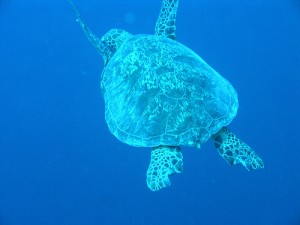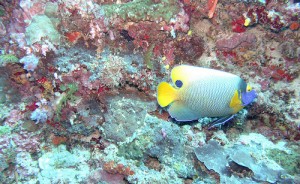The following is a guest post by Jacob Mojiwat.
 There is a magical beauty surrounding the tiny island of Sipadan, off the coast of Sabah, Malaysia. This island, secret to many people and divers as well, is well-preserved because the government has banned any commercial development in order to protect the delicate ecosystem. Because I live on the island and enjoy scuba diving, I am, of course, partial to its unique beauty both above and below the water.
There is a magical beauty surrounding the tiny island of Sipadan, off the coast of Sabah, Malaysia. This island, secret to many people and divers as well, is well-preserved because the government has banned any commercial development in order to protect the delicate ecosystem. Because I live on the island and enjoy scuba diving, I am, of course, partial to its unique beauty both above and below the water.
Whether it’s snorkeling, scuba diving, bird watching, or just laying on the beach and soaking up the rays, Sipadan is a hidden gem of wonders. It takes dedication and desire to get to, but once there, you will discover an unparalleled jewel of the ocean. You can take a short boat ride from the nearby resort islands of Mataking and Pompong also located in the Sulu Sea. Once exploring Sipadan’s waters, you can experience viewing some of the most beautiful, rich and diverse coral and marine life in the world. And when you’re not diving into a colorful vision of coral and fish species, you can enjoy using those binoculars to view one of the most diverse and wondrous bird populations. So spectacular are the migratory birds that the island was deemed a bird sanctuary in 1933. For those who seek to experience a pristine marine and wildlife exploration, Sipadan should be on your “must do” list.
Glorious Fish Galore
Barracudas are probably one of the most prevalent fish sightings for divers in Sipadan. Jumping into the crystalline water at the Barracuda Point dive site, one will come upon huge cascading swirls of silvery, striped chevron barracuda. Swirls can be so large, divers can actually swim up the middle of the funnel-like formation. These barracuda vortexes are stunning and the fish often approach just inches from your mask, which can be both unnerving and exhilarating. The currents are strong at this diving site, so don’t go down to far or you might get swept away from the island. But it is these strong currents that bring in a diverse fish population that feed off each other.
 Barracuda Point begins with a wall that merges into a ledge at around 22 meters where resting white-tip sharks or marauding grey reef sharks can be seen. Eagle rays, turtles and bumphead parrotfish are also abundant. Divers have said the sheer numbers of fish surrounding the island is astounding and that at Barracuda Point, drift diving is the best and safest way to go about exploring. It is also one of the best places in the world to get pictures of barracuda. Barracuda Point is so spectacular it consistently gets voted as one of the top five dive sites in the world. Green turtles can also be seen at this site. But more are located at Turtle Cavern located at the appropriately named “Drop Off” dive site, where a mere 20 feet from shore, a wall plunges into the sea at a dazzling 2,800 feet. The entrance to Turtle Cavern is 70 feet down along a wall that is encrusted with a wide variety of colorful coral. Turtles swim in and out of the cavern and along the wall. Because the cavern is difficult to navigate, all divers must be accompanied by a guide if they want to explore.
Barracuda Point begins with a wall that merges into a ledge at around 22 meters where resting white-tip sharks or marauding grey reef sharks can be seen. Eagle rays, turtles and bumphead parrotfish are also abundant. Divers have said the sheer numbers of fish surrounding the island is astounding and that at Barracuda Point, drift diving is the best and safest way to go about exploring. It is also one of the best places in the world to get pictures of barracuda. Barracuda Point is so spectacular it consistently gets voted as one of the top five dive sites in the world. Green turtles can also be seen at this site. But more are located at Turtle Cavern located at the appropriately named “Drop Off” dive site, where a mere 20 feet from shore, a wall plunges into the sea at a dazzling 2,800 feet. The entrance to Turtle Cavern is 70 feet down along a wall that is encrusted with a wide variety of colorful coral. Turtles swim in and out of the cavern and along the wall. Because the cavern is difficult to navigate, all divers must be accompanied by a guide if they want to explore.
There are four species of turtles on Sipadan: the Leatherback, the Olive Ridley, the Hawsbill and the Green Turtle. In 1964, the island became part of the turtle egg native reserve of Sabah, and Jacques Cousteau featured Sipadan in his 1983 film, “Ghost of the Sea Turtles.” The movie shed light on the necessity of preserving the wondrous creatures and prompted him to say, “I have seen other places like Sipadan, 45 years ago, but now no more. Now we have found an untouched piece of art.” This is truly a testament to Malaysia’s dedication to preserving the island. The Coral Garden dive site has barracuda, as well as plenty of trevally. Clown and titan triggerfish can be spotted, as well as parrotfish, wrasse and schools of snapper. And beware of the Grey reef and leopard sharks that have been seen passing by! The Bumphead Parrotfish are a popular attraction at Sipadan Island. These massive fish munch on coral with their huge teeth, leaving plumes of coral sand to float up above them.
Spectacular Coral Abound
 Formed by living coral growing on top of a now extinct volcanic cone in the heart of the Indo-Pacific basin, the island rises 600 meters from the seabed. Sipadan itself is only .5 km long and 200 meters wide and can be walked in about 25 minutes. The crystal blue water with a visibility depth of 60 to 200 feet provides a backdrop for the hard and soft pristine coral. The island is known to have the largest variety of soft coral in the world, and Gorgonian fans, sea whips and feather stars abound. The coral life is lush and breathtaking which is wonderful for underwater photography.
Formed by living coral growing on top of a now extinct volcanic cone in the heart of the Indo-Pacific basin, the island rises 600 meters from the seabed. Sipadan itself is only .5 km long and 200 meters wide and can be walked in about 25 minutes. The crystal blue water with a visibility depth of 60 to 200 feet provides a backdrop for the hard and soft pristine coral. The island is known to have the largest variety of soft coral in the world, and Gorgonian fans, sea whips and feather stars abound. The coral life is lush and breathtaking which is wonderful for underwater photography.
In 1990, Sipadan became renowned as a spectacular site for serious divers. It also had five resorts on its northern beaches. But as the divers flocked, the coral reef suffered. Two years later a British conservation officer warned about a deterioration of Sipadan’s coral. Divers and snorklers were being careless, causing easily apparent coral damage. And where there was a lot of boat and diver traffic, sediment and silt became stirred up. This choked and suffocated the coral polyps. Mother Nature reaped its share of wounds on the coral reef as well when tropical storm Greg demolished shallow parts of the reef. The rubble left behind can still be seen. And global warming, which brings rising water temperatures, has set the coral ecosystem off balance with some coral bleaching as a result. The beautiful reefs of Sipadan make it a major tourist draw for Malaysia, but its delicate beauty is under threat and the government has set restrictions on the number of tourists that visit the island each day. In 2006 a barge hit the island, causing much damage to the coral. Luckily through the natural process of healing, Sipadan’s coral have returned to their glorious beauty.
Wonder Above the Sea
As if there isn’t enough beauty beneath the waves, Sipadan has much to amaze you above the sea. Although the oceanic island is known for its scuba diving, it is also heaven for bird watching. With 47 different species congregating on the island, a novice or professional bird watcher will never be bored. There is a plenitude of colorful, winged beauties, including Frigates, Sea Eagles, Terns, and Kingfishers that glide across the miniature island. Sipadan also serves as an integral stopover point for migratory birds like the Greater Sand Plover, common Sandpiper, Wood Sandpiper, as well as the Nicobar Pigeon, which flies from China during the cold seasons. An elusive bird with a distinctive cat-like cry is the Megapode bird. The large brown bird comes out in the morning scratching the ground with what look like chicken claws looking for fallen fruits, snails and worms. The cackle of the white-collared Kingfisher often fills the air. The Kingfisher nests are lined with fish bones, making good use of its prey. Kingfishers are unique, exotic-looking birds that are brightly colored and feature short legs and tails, big heads, and long, powerful beaks. The delightful coos of the Pied Imperial Pigeon are a strong contrast to the Kingfisher. The pigeon’s creamy whiteness stands out beautifully amongst the emerald green foliage of the island.
On the ground are the unique Robber Crabs, also known as Coconut Crabs–the largest of the terrestrial anthropoids. These mammoth crustaceans feed on coconuts, prying the husks open with their huge claws. Who ever heard of a coconut-eating crab? Only on Sipadan. Other land creatures that are considered rare finds are the snails with distinctive designs and skinks with their blue tails. Skinks love laying in the sun to absorb the sun’s warmth and help regulate their body’s temperature.
If you plan on visiting Sipadan, whether it be for diving, bird-watching, or just to bask in the sun’s warmth like the skink, then get ready to be amazed by this pristine ecosystem both above and below water. Sipadan has been on many “best of” lists, and for good reason. It will likely grow in fame throughout the years as it becomes more discovered. It’s good to know the plentiful and beautiful supply of fish, coral, birds and land creatures will be well preserved for all to enjoy.
Jacob Mojiwat is passionate about sharing the wonders of scuba diving with others. He is the owner of AsiaDivingVacation.com. His dive company takes divers diving in Sipadan Malaysia as well at other Asia dive destinations.
Photo credit:
Patrik Axelsson
Matthew Lee


